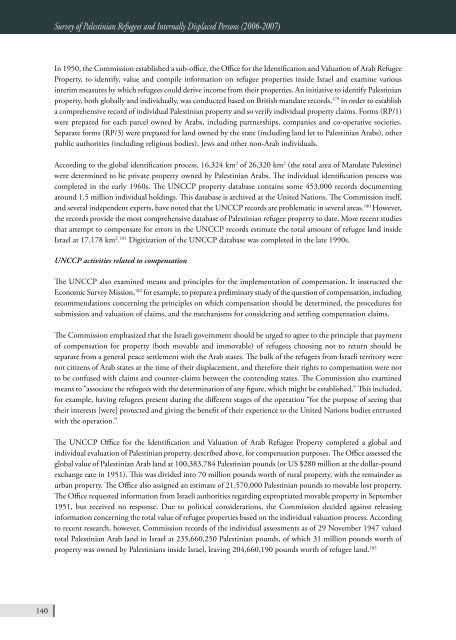BADIL Resource Center for Palestinian Residency and Refugee
BADIL Resource Center for Palestinian Residency and Refugee
BADIL Resource Center for Palestinian Residency and Refugee
Create successful ePaper yourself
Turn your PDF publications into a flip-book with our unique Google optimized e-Paper software.
140<br />
Survey of <strong>Palestinian</strong> <strong>Refugee</strong>s <strong>and</strong> Internally Displaced Persons (2006-2007)<br />
In 1950, the Commission established a sub-office, the Office <strong>for</strong> the Identification <strong>and</strong> Valuation of Arab <strong>Refugee</strong><br />
Property, to identify, value <strong>and</strong> compile in<strong>for</strong>mation on refugee properties inside Israel <strong>and</strong> examine various<br />
interim measures by which refugees could derive income from their properties. An initiative to identify <strong>Palestinian</strong><br />
property, both globally <strong>and</strong> individually, was conducted based on British m<strong>and</strong>ate records, 179 in order to establish<br />
a comprehensive record of individual <strong>Palestinian</strong> property <strong>and</strong> so verify individual property claims. Forms (RP/1)<br />
were prepared <strong>for</strong> each parcel owned by Arabs, including partnerships, companies <strong>and</strong> co-operative societies.<br />
Separate <strong>for</strong>ms (RP/3) were prepared <strong>for</strong> l<strong>and</strong> owned by the state (including l<strong>and</strong> let to <strong>Palestinian</strong> Arabs), other<br />
public authorities (including religious bodies), Jews <strong>and</strong> other non-Arab individuals.<br />
According to the global identification process, 16,324 km 2 of 26,320 km 2 (the total area of M<strong>and</strong>ate Palestine)<br />
were determined to be private property owned by <strong>Palestinian</strong> Arabs. The individual identification process was<br />
completed in the early 1960s. The UNCCP property database contains some 453,000 records documenting<br />
around 1.5 million individual holdings. This database is archived at the United Nations. The Commission itself,<br />
<strong>and</strong> several independent experts, have noted that the UNCCP records are problematic in several areas. 180 However,<br />
the records provide the most comprehensive database of <strong>Palestinian</strong> refugee property to date. More recent studies<br />
that attempt to compensate <strong>for</strong> errors in the UNCCP records estimate the total amount of refugee l<strong>and</strong> inside<br />
Israel at 17,178 km 2 . 181 Digitization of the UNCCP database was completed in the late 1990s.<br />
UNCCP activities related to compensation<br />
The UNCCP also examined means <strong>and</strong> principles <strong>for</strong> the implementation of compensation. It instructed the<br />
Economic Survey Mission, 182 <strong>for</strong> example, to prepare a preliminary study of the question of compensation, including<br />
recommendations concerning the principles on which compensation should be determined, the procedures <strong>for</strong><br />
submission <strong>and</strong> valuation of claims, <strong>and</strong> the mechanisms <strong>for</strong> considering <strong>and</strong> settling compensation claims.<br />
The Commission emphasized that the Israeli government should be urged to agree to the principle that payment<br />
of compensation <strong>for</strong> property (both movable <strong>and</strong> immovable) of refugees choosing not to return should be<br />
separate from a general peace settlement with the Arab states. The bulk of the refugees from Israeli territory were<br />
not citizens of Arab states at the time of their displacement, <strong>and</strong> there<strong>for</strong>e their rights to compensation were not<br />
to be confused with claims <strong>and</strong> counter-claims between the contending states. The Commission also examined<br />
means to “associate the refugees with the determination of any figure, which might be established.” This included,<br />
<strong>for</strong> example, having refugees present during the different stages of the operation “<strong>for</strong> the purpose of seeing that<br />
their interests [were] protected <strong>and</strong> giving the benefit of their experience to the United Nations bodies entrusted<br />
with the operation.”<br />
The UNCCP Office <strong>for</strong> the Identification <strong>and</strong> Valuation of Arab <strong>Refugee</strong> Property completed a global <strong>and</strong><br />
individual evaluation of <strong>Palestinian</strong> property, described above, <strong>for</strong> compensation purposes. The Office assessed the<br />
global value of <strong>Palestinian</strong> Arab l<strong>and</strong> at 100,383,784 <strong>Palestinian</strong> pounds (or US $280 million at the dollar-pound<br />
exchange rate in 1951). This was divided into 70 million pounds worth of rural property, with the remainder as<br />
urban property. The Office also assigned an estimate of 21,570,000 <strong>Palestinian</strong> pounds to movable lost property.<br />
The Office requested in<strong>for</strong>mation from Israeli authorities regarding expropriated movable property in September<br />
1951, but received no response. Due to political considerations, the Commission decided against releasing<br />
in<strong>for</strong>mation concerning the total value of refugee properties based on the individual valuation process. According<br />
to recent research, however, Commission records of the individual assessments as of 29 November 1947 valued<br />
total <strong>Palestinian</strong> Arab l<strong>and</strong> in Israel at 235,660,250 <strong>Palestinian</strong> pounds, of which 31 million pounds worth of<br />
property was owned by <strong>Palestinian</strong>s inside Israel, leaving 204,660,190 pounds worth of refugee l<strong>and</strong>. 183

















